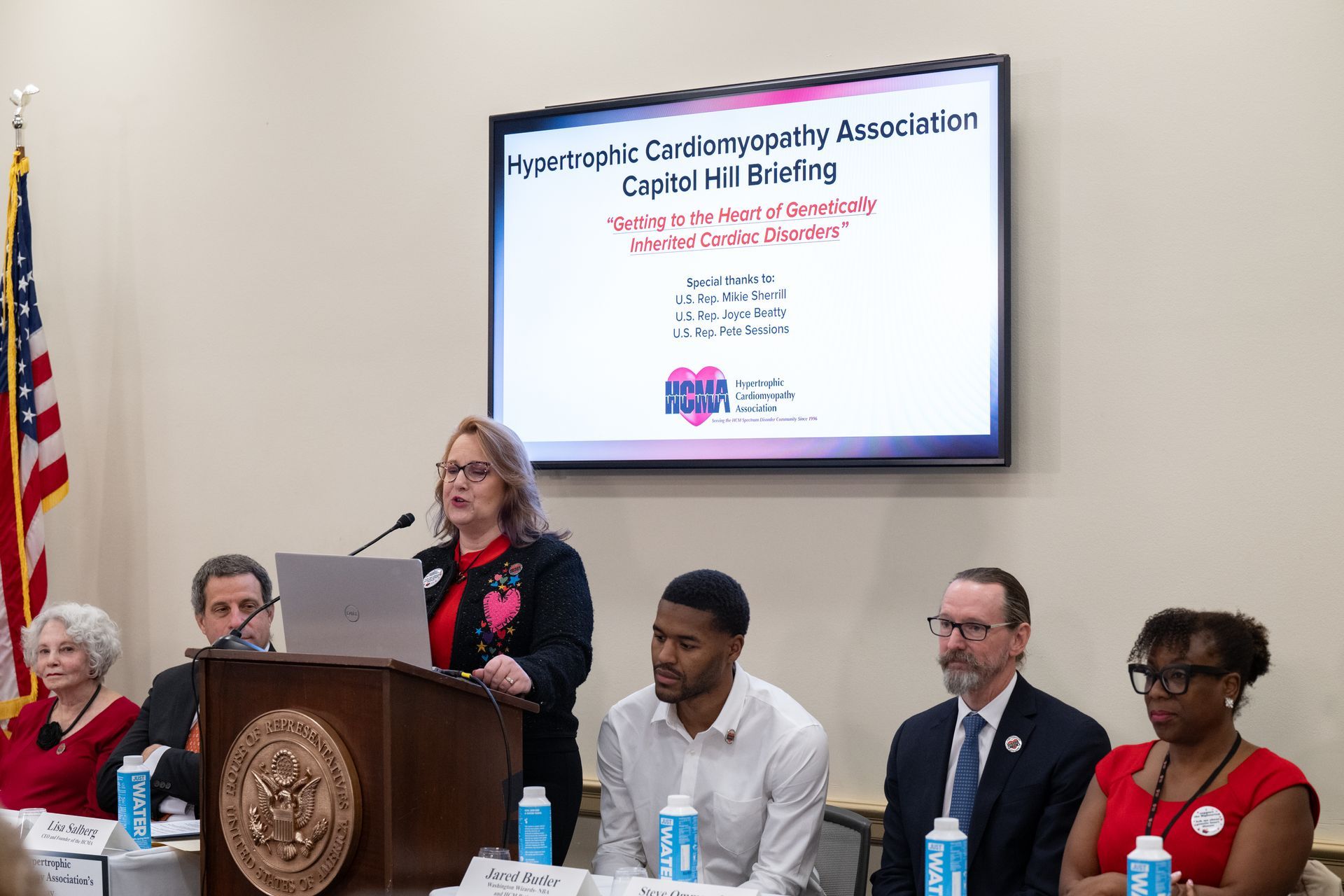Danon Disease
What is Danon Disease?
Danon Disease is very rare. Up to 4% of "HCM patients" actually have Danon Disease. Most people with Danon have heart problems. Danon also affects the liver, skeletal muscles, and eyes. It can cause developmental delay, learning disabilities, and mood disorders.

Danon Disease is a rare genetic condition caused by a mutation or deletion on the X chromosome. It is a storage disorder that causes the build-up of toxic materials in the body. These toxins can cause issues with the heart, muscles, and brain. Because Danon is associated with the X chromosome, it looks different in XX (typically female) people than in XY (typically male) people.
What Causes Danon Disease?
A change in the LAMP2 gene makes cells unable to remove excess material. The buildup can cause problems all over the body. Cardiomyopathy, muscle weakness, eye problems, and intellectual deficits are possible. Cells have a recycling system to help remove stuff the cell no longer needs. When there are problems with the LAMP2 protein, the lysosomes (recycling trucks) don’t work right. Imagine the recycling truck is low on oil, and the engine isn’t running well.
What heart symptoms does Danon cause?
Heart symptoms in Danon depend on the heart's appearance. As with HCM, the heart can be obstructed or unobstructed. With dilated cardiomyopathy (DCM), the heart will be dilated. Common symptoms are shortness of breath, palpitations, chest pain, tiredness, and lightheadedness. Abnormal heart rhythms can be serious or just feel bad. Less often, there may be fainting.
How is Danon like HCM?
About 1-4% of those diagnosed with HCM are later found to have Danon Disease with genetic testing. That's because Left Ventricular Hypertrophy (LVH) is seen in both diseases. Up to 25% of Danon patients also have outflow tract obstruction.
Danon can look like HCM, especially in females first showing heart symptoms as adults. Heart signs and symptoms in Danon Disease include severe thickening of the heart walls. This can change to dilated cardiomyopathy. In dilated cardiomyopathy, the walls thin and balloon out. Abnormal heart rhythms seen in Danon include atrial fibrillation and ventricular tachycardia/fibrillation. Other rhythms are pre-excitation, 1st-, 2nd-, and 3rd-degree heart block, and sinus node dysfunction. Atrial fibrillation and ventricular tachycardia/fibrillation are also found in HCM. Differences between Danon and HCM include a weak (hypokinetic) left ventricle in Danon. HCM hearts are usually hyperkinetic - they beat very hard.
Heart issues are the biggest cause of health problems in Danon Disease.
Progression of heart disease causes many symptoms in Danon. The thick heart can be so overworked that it becomes hypokinetic. This is often followed by wall thinning and possible dilation.
Young patients grow heart muscle quickly. This causes severe LVH, which can separate Danon from HCM and other forms of LVH. Damage to the heart muscle due to Danon often causes high troponin levels seen in blood tests. Scarring in the heart muscle can grow enough that the muscle becomes weak and the heart walls thin out. This is similar to end-stage HCM or dilated cardiomyopathy (DCM). We don't know if the dilated heart in female Danon patients begins as HCM and becomes dilated, or if it begins as DCM. This is because females are often diagnosed much later.
How is Heart Disease in Danon Diagnosed?
Echocardiogram
Left ventricular hypertrophy (LVH) is the most common cardiac sign of Danon Disease. The hypertrophy is often extreme, over 30 mm. About 25% of Danon patients have outflow tract obstruction, also seen in HCM. In female patients, 30-50% have dilated cardiomyopathy instead of LVH. Some female patients have right ventricular hypertrophy (RVH).
EKG/ECG, holter/event/ambulatory monitor
Heart monitors help find problems with the heart's electrical system. A 24-hour or longer Holter monitor should be done every 6-12 months. For some, an implanted loop recorder may be recommended. Atrial flutter, atrial fibrillation, and ventricular arrhythmias happen in about 60% of patients. Wolff-Parkinson-White syndrome is common in Danon disease. Heart block or sinus node dysfunction requiring a pacemaker is also common. A slow heart rate may also be present. Cardiac arrest and sudden arrhythmia death can be the first disease presentation. Dangerous heart rhythms are common due to severe thickening and heart failure.
MRI/CMR
Cardiac MRI (CMR) can show patterns of thickening in the heart. It can also show scarring or fibrosis using late gadolinium enhancement. In male patients, LVH is mostly concentric with normal ejection fraction. Female patients have asymmetric LVH, RVH, and either hypertrophic or dilated cardiomyopathy.
Exercise Testing/CPET/VO2 Max
Exercise or stress testing can help find the risk of heart problems during exercise. This helps the doctor to recommend safe types of exercise for each patient.
Laboratory Tests: natriuretic peptides, troponin
Blood tests for troponin and NT-proBNP show whether the heart is under stress.
Genetic testing
Genetic testing is essential to tell Danon Disease from other causes of LVH. A genetic counselor should collect the family history as part of this process.
Family screening
Once someone is diagnosed with Danon Disease, their family is offered genetic testing. The parents, siblings, and any children of the patient are tested first. If a parent is found to have a mutation for Danon, their side of the family should be screened. If any siblings have a Danon mutation, their children should be screened. This is called "cascade testing." Although Danon is a genetic condition, up to 40% of cases may be caused by a "de novo" gene mutation. De novo means that it's a new mutation that has not been passed down from either parent. Mutations are mostly from the mother because men with Danon are too sick to father children.
Gender differences in Danon
There are differences between males and females in Danon Disease. A recent study found that females were usually diagnosed later in life than males. Females could have either HCM or DCM and typically had issues only in the heart. Males usually had HCM and also had issues in other areas of the body, not just the heart.
Those with XY chromosomes usually have a more severe form of Danon. This is because the disease is linked to the X chromosome. Males only have one X chromosome. Males with Danon often progress to the need for a heart transplant or death between the ages of 10 and 29. Those with XX chromosomes have two chances for one normal X chromosome. They usually have a milder form of the disease. Females often show symptoms up to 15 years later than males. Their hearts can also be severely affected, leading to a need for a heart transplant. This is less common in females than males.
Testing beyond the heart
Danon can affect many body systems. Regular tests should include blood and urine tests for liver function. Patients should also have eye exams and physical exams for muscle weakness. Children should be tested for developmental delays.
- Skeletal muscle symptoms include weakness and pain.
- Visual changes in the retina of the eye can lead to vision loss.
- Young Danon patients should be screened for learning disabilities. Some are diagnosed with ADHD before Danon is confirmed.
- Danon patients may suffer from anxiety or mood disorders.
- An enlarged liver and high liver enzymes can be part of Danon.
Treatment
There are no guidelines for treating Danon Disease, and management is based on expert opinion. Heart care in Danon patients is often based on HCM guidelines. However, this may not be the best care as HCM and Danon are different. Very little HCM research includes Danon patients. Some HCM guidelines mention genetic testing if the cardiologist suspects Danon in a patient with LVH. Preventive implantation of an ICD is suggested. In advanced heart failure, doctors may consider a heart transplant. Catheter ablation is possible for tachycardia or other abnormal heart rhythms.
Loop Recorder, ICD
If the patient faints (syncope), an implanted loop recorder can show if an arrhythmia is causing fainting. If a dangerous arrhythmia, such as ventricular tachycardia, is seen, an ICD will be recommended. An S-ICD should be considered in young patients who don't need pacing. The S-ICD can minimize the risk of infection and other complications. Patients should avoid heavy exercise and competitive sports. This will reduce the risk of stress-provoked arrhythmia.
Gene Therapy
Gene therapy is being investigated for the treatment of Danon Disease. This therapy is experimental and not yet approved for general use. A 2024 study in 7 young male Danon patients showed promising results. More study is needed to determine if gene therapy is effective in treating Danon Disease.
Treatment of other body systems
Symptoms are treated to make life easier. Treatments include medications and physical therapy. It's important to have an expert doctor coordinate medications and other treatments needed.
Medical and related Therapy
There are no treatments just for Danon disease. To help with Danon's effects on the body, specialist doctors are needed. There are doctors in cardiology, neurology, genetics, ophthalmology, rehabilitation medicine, and physical therapy. For heart disease, doctors will choose medicines such as diuretics for CHF. Antiarrhythmics can help control abnormal heart rhythms. Beta-blockers (and other HCM medications) are used for other heart symptoms. Physical therapy is recommended for muscle pain. Educational support can help with learning disabilities.
Implications of improving treatment
Improvements in treatment for males with Danon mean that there's more risk of passing it on. Genetic counseling for affected families helps them understand how Danon is passed on. A counselor will discuss risks and technologies for those who want to test before pregnancy. In-vitro fertilization (IVF) can screen embryos to avoid Danon before implantation.
Citations:
International Consensus on Differential Diagnosis and Management of Patients With Danon Disease: JACC State-of-the-Art Review. JACC 2023, Oct, 82 (16).
Phase 1 Study of AAV9.LAMP2B Gene Therapy in Danon Disease. NEJM 2024, Nov, 392 (10).

 Translate
Translate